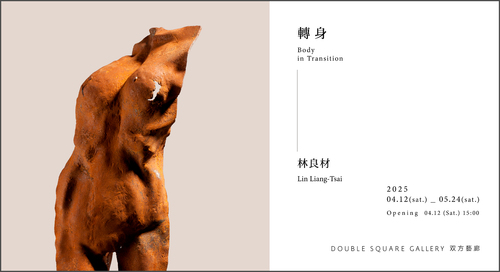Lin Liang-Tsai solo exhibition
4/12 (Sat) - 5/24/2025 (Sat)
Lin Liang-Tsai

Double Square Gallery is delighted to present artist Lin Liang-Tsai’s solo exhibition, Body in Transition, which will run from April 12 to May 24, 2025. This exhibition features a selection of over a dozen sculptures from the artist’s decades-long career, marking the gallery’s second collaboration with this outstanding artist following his 2020 solo exhibition, In Search of the Absolute, at the gallery. Through this exhibition, Double Square Gallery showcases the cream of the crop of Lin’s sculptural creations and explores how he, born deaf and mute, has transformed adversity into artistic expression, guiding viewers to navigate the complex dimensions of his art.
The exhibition title, “Body in Transition,” accurately captures Lin’s unique portrayal of dynamic rhythm and movement in his work. The term “transition” encapsulates the artist’s years of creative exploration, during which he observes human and animal forms to transform his insights into artistic expressions and translates external appearances into representations of a robust inner spirit. It also symbolizes his artistry in shaping cold, rigid metal into artworks that exude a sense of warmth. The word “body” represents the various physical forms depicted in Lin’s sculptures. As Lin approaches eighty, the title pays homage to the resilient physique shaped by his years of laborious creative processes, highlighting his unwavering spirit despite the challenges he has faced along the way.
Lin’s sculpture primarily features cast iron and copper. He once remarked that, much like people, the condition of these materials evolves over time, and he focuses on combining them to forge new expressions and ideas. As time progresses, the surfaces of his works develop a layered texture that peels and weathers, while the rust gradually transitions into a warm orange-red, infusing rich vitality into his sculptures. He skillfully employs techniques such as cutting, hammering, and welding, breathing new life into rigid metal. Moreover, Lin’s silent world becomes a distinctive advantage, enabling him to concentrate fully on his art despite the booming clamor of metalworking in the creative process, which many may find unpleasant and unbearable. Undisturbed by the external world, he focuses entirely on his art, capturing the essence of form through his keen observation. However, he does not aim for minute representation; instead, he uses a hammer to outline fundamental, succinct shapes. With no distractions, Lin successfully infuses metal, a usually rigid medium, with a sense of dynamic movement through his skilled craftsmanship. When appreciating Lin’s sculptures, viewers can focus on the various facets of his work, observing how his manipulation of surface textures transcends mere imitation of reality to unveil the inner space of his sculptural pieces. Art historian Chen Kuang-Yi notes that “the sculptures (by Lin Liang-Tsai) may seem static, but they possess the capacity to engage with both space and the viewer.”
This exhibition showcases works from over two decades of the artist’s journey. By employing welded metal rods, Battle ingeniously conveys a figure’s steady posture and muscular power through the curves of the lower limbs, perfectly capturing the moment just before a warrior springs into action. In contrast, his Strolling Series, while using similar techniques, exudes a more relaxed mood, free from the tense energy of confrontation, highlighting Lin’s mastery in depicting bodily movement.
Lin Liang-Tsai (b. 1947 in Erlin, Changhua) is a naturally deaf-mute artist with exceptional artistic talent. In 1984, he pursued further studies at the Royal Academy of Fine Arts in Brussels, Belgium (Académie Royale des Beaux Arts de Bruxelles). In 1990, he was chosen to create the European June 4th Democratic Monument, titled The Torch of Freedom. He received the Award of the Royal Academy of Fine Arts in 1989 and the Wu San-Lien Arts Award in 2008. He has exhibited in various countries, including Belgium, France, Germany, Australia, and Korea.. His artworks are included in the collections of several prestigious institutions, such as the Royal Academy of Fine Arts in Belgium, the Royal Museum of Fine Arts of Belgium, the National Taiwan Museum of Fine Arts, the Taipei Fine Arts Museum, and the Kaohsiung Museum of Fine Arts, among others.